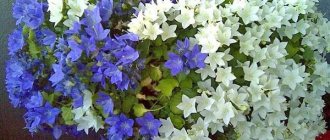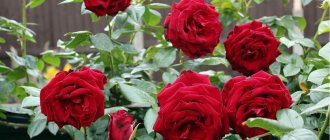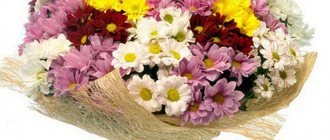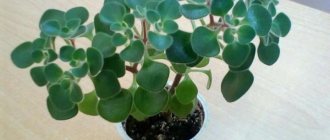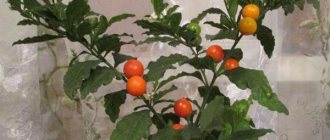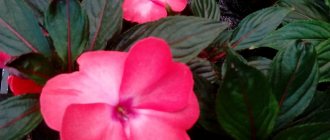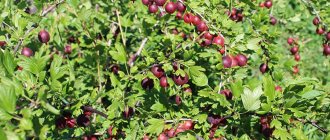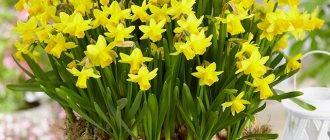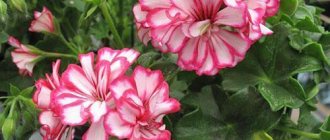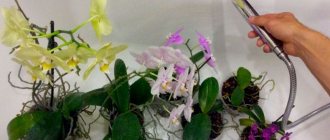These plants are native to Central America and in the wild they live in the highlands along the Pacific coast. The Christmas star was first described in 1834 by the German scientist Johann Klosch (1), who also gave it a Latin name in honor of the botanist Joel Poinsett, who was the first American ambassador to Mexico. But in Russian botanical literature this flower has a more prosaic name - beautiful spurge (Euphorbia pulcherrima). Yes, yes, poinsettia belongs to the genus Euphorbia and is a member of the Euphorbiaceae family.
In nature, poinsettias reach a height of 3 m, but in cultivation they are much more modest, and modern varieties are completely short - no higher than 30 cm. They bloom from December to February, the peak of their decorative value falls on the main winter holidays - hence the name “Christmas star” . In Europe and America, this flower is a symbol of Christmas, and every year on the eve of the holiday, about 60 million poinsettias in pots are sold around the world. By the way, the main supplier of these plants is not Holland, as many people think, but the USA - they provide 50% of the world market.
The most interesting thing is that poinsettias are sold only at the moment of flowering, but the flowers themselves are of no interest - they are small and inconspicuous. But the plant came up with a trick - when the buds appear, the upper leaf bracts turn bright red, which attracts pollinating insects. It is these leaves that give the Christmas star its unique appearance.
Varieties of Christmas star flower
There are not so many varieties of the Christmas star, but their number is growing from year to year. They differ mainly in the color of the upper leaves. The very first, Red Star , was released in 1919 (2). And now the most popular varieties are:
- Carousel Pink - with soft pink bracts, which have green veins;
- Da Vinci - delicate pinkish variety with red splashes;
- Jester Red - it has bright red leaves with dark veins;
- Jingle Bells - with red upper leaves, on which there are white inclusions, similar to snow flakes;
- Marble – with cream bracts and a pink-red heart-shaped inflorescence (3);
- Premium Miro – with white and pink bracts;
- Premium Red - a classic variety with red leaves at the top;
- Strawberry and cream - a very unusual variety with pink-purple leaves with a heavily cut white edge;
- Winter Rose White - with white bracts that are slightly compressed and resemble rosebuds.
Variety Carousel Pink. Photo: wikipedia.org
Variety Jingle Bells. Photo: wikipedia.org
Da Vinci variety. Photo: wikipedia.org
Variety Jester Red. Photo: wikipedia.org
Premium Miro variety. Photo: wikipedia.org
Benefits, harms and properties
According to superstitions, cordilina has a positive effect on creativity and, being a true peacemaker, maintains a warm atmosphere in the house, helps restore the aura, neutralizes quarrels and suppresses gossip.
It is recommended to keep Cordilina in houses where strangers often come : thanks to her, the owners will never feel tired and empty after the guests leave.
In the teachings of Feng Shui, cordilina combines the energy of wood and fire. By placing it in the corner of the room, you can activate the Chi energy. In addition, the plant belongs to the Yang type and is not recommended for placement near working and sleeping places. The optimal part of the house for cordilina is the south or east side.
Caring for a Christmas star flower at home
You probably see these luxurious flowers at your friends’ houses during the New Year holidays. However, you won’t find them on windowsills in spring or summer. Why? Yes, because poinsettias are very whimsical plants. There is an art to pleasing them! Not even every greenhouse undertakes to add them to its collection. By the way, in America and Europe, the Christmas star is considered a disposable plant: they treat it the same way as bouquets - admired during the holidays and thrown away.
But if you still decide to fight until victory, then take into account all the whims of this flower.
Important! Christmas star juice is poisonous! If it is accidentally licked by an animal or child, it can cause poisoning - vomiting, diarrhea, serious irritation of the gastrointestinal tract and even contact dermatitis. Therefore, you only need to replant and propagate the plant while wearing gloves. The flower can also cause allergies in people who react to plant pollen.
Priming
Poinsettia loves slightly acidic soil (pH – 6 – 6.5) so you need to add high-moor peat to the soil composition. There are 2 options for soil mixtures (2) that are used to grow a Christmas star:
- peat or compost, leaf soil, turf soil, crushed pine bark and sand in a ratio of 1:1:1:1:1;
- peat, turf soil, humus and sand in a ratio of 1:1:1:1.
Temperature
The Christmas star does not like cold or heat; it needs a temperature no higher than 20 °C. During the flowering period it should not fall below 17 °C. During the dormant period, which, unlike other flowers, for poinsettias occurs from March to October, you can put them in a cool, shaded place where the temperature will not be lower than 12 °C.
Poinsettia does not tolerate drafts and sudden temperature fluctuations, so when ventilating, always remove the flower from the windowsill.
Lighting
The Christmas star loves plenty of sun during the flowering period. And this is the main problem, because from December to February in the middle zone there are the shortest days and the plant is sorely lacking in light. Therefore, if you are going to preserve the plant, you will have to supplement it with phytolamps - they should be turned on for 8 - 9 hours a day. But in summer, poinsettias, on the contrary, need to be shaded from the scorching sun (3).
For poinsettia to bloom, it is important that there is no more than 8 hours of daylight - if it is 12 hours, the buds will not form and beautiful colored leaves will not appear.
Humidity
In winter, poinsettias need to be watered frequently, about 2 - 3 times a week, but it is important not to overwater - the flower does not like excess moisture. The top layer of soil should dry out slightly between waterings. In the summer, when it’s hot, you need to water it abundantly, because peat-based soil dries out very quickly.
Poinsettia leaves need constant moisture. Photo: wikipedia.org
The water must be warm, at least room temperature, and certainly not from the tap. Water the poinsettia at the root. But the leaves also need constant moisture, otherwise they may lose color. Therefore, you need to spray the flower often, especially in winter.
Fertilizers and fertilizers
The vast majority of indoor plants are fed from March to September, but for poinsettia the opposite is true - its active period and flowering period is in the winter, so it needs to be fertilized from November to March every 2 weeks. Any liquid complex fertilizer will do.
In summer, during the dormant period, fertilizers are also needed, but they are given rarely - about once every 1.5 months.
Trimming
In March, poinsettia usually fades and a dormant period begins - at this time the flower must be cut by about 1/3, leaving 10 centimeters above the ground. After pruning, the plant should be placed in the shade and not watered until May (3).
At the beginning of May, the Christmas star should be transplanted into a new pot and watered thoroughly. When new shoots appear, you need to leave 4 - 5 of the strongest ones and cut out the rest.
Crops with red-variegated foliage
There are not many such plants. Some of them have multi-colored leaves, others surprise with the play of bright colors: red-green with white, purple or yellow streaks. Let's look at the most commonly grown and impressive-looking deciduous house flowers.
Croton
Belongs to the Euphorbiaceae family. The plant is endowed with variegated leaves streaked with yellow, green, white and red colors. Thanks to its decorative color, the plant decorates not only residential premises, but also offices. The leaves of young plants are usually green, but over time they change color to yellow, red, playing with rich tones. Crotons are capricious, do not respect drafts and bright sunlight, which causes black burns to appear on the leaves. A temperature of 20 degrees in summer and 15-16 degrees in winter is favorable for the plant. It also needs regular watering, spraying, and fertilizing in spring and autumn. Often scale insects and spider mites appear on it, especially in rooms with a dry atmosphere and elevated temperatures.
Coleus
This tropical plant belongs to the Lamiaceae family, also called “poor man's croton”, since the variegated color of its foliage is similar to the color of an expensive flower. Dense foliage develops on self-flowing, tight branches 30-40 cm long, and its beauty does not change throughout the year. The leaves are decorated with intricate patterns that combine different colors: deep red, white, yellow, dark purple, burgundy and green in different shades. The flower is not whimsical. Loves bright light, warmth, high humidity, propagated by cuttings and seeds. It tolerates frequent watering and fertilizing. Aphids are rare guests.
Royal begonia
A spectacular, royal indoor plant with red-burgundy leaves immediately attracts attention. Compared to other species, it is a favorite for growing at home and in gardens. The culture has a creeping root system, the leaves are large with clearly defined edges in the shape of a beveled heart. The maximum height of the plant is 40 cm. It is not difficult to care for, since it does not require spraying, frequent replanting or fertilizing. But the flower prefers warmth, nutritious soil and good lighting. Excess moisture in the soil and temperatures below 10 °C are harmful.
Hypestes
It is a perennial with red-green leaves covered with spots of light colors. At home, you can most often find the leafy variety. The hyposthes bush branches well and grows to a height of up to 50 cm. Its stems are hard and plump with dense foliage. The plant loves frequent and abundant watering and needs bright lighting. Otherwise, the leaves will turn pale, the patterns will be smeared and will be difficult to see. The plant can change color depending on the dosage and type of fertilizing.
Caladium
The plant is loved by flower growers all over the world. Colorful spotted foliage with veins of purple, crimson, pink with a variety of patterns and strokes attracts the attention of others. Caladium needs diffused bright light, warmth, spraying and regular watering during its growth. Feeding is required twice a month. The flower reproduces by tubers, rarely gets sick and is resistant to pests. Replanting is necessary every year in the spring into a container larger than the previous one.
Reproduction of Christmas star flower at home
Poinsettia is propagated by apical cuttings - the shoots that remain after pruning in May are suitable. However, rooting them is not so easy.
Cuttings are cut with 4 - 5 leaves. The bottom ones are removed, leaving only the top 2. After this, they are placed in warm (30 - 40 ° C) water for 30 minutes so that the milky juice comes out of them. After this, the cuttings are dusted with a root formation stimulator (Heterauxin or Kornevin) and planted in pots in loose, moisture-absorbing soil. The ideal option for rooting is a mixture of peat and sand in a 1:1 ratio (2).
The cuttings are buried 1.5 - 2 cm into the soil, no more - when planted deep they begin to rot. Pots with cuttings should be kept in a warm room (20 - 25 ° C) with moderate lighting. It is also important that the soil temperature is about 20 °C, so do not place the pots on the windowsill if there is blowing air from the window.
After 10 - 15 days, callus forms on the poinsettia cuttings, on the 20th day roots appear, and after 25 - 30 days the cuttings are completely rooted (2) and can be transplanted into larger hills.
There are not many varieties of the Christmas star. Photo: wikipedia.org
Replanting Guzmania - when needed
The roots of the plant develop extremely slowly, and therefore it does not need regular replanting. But it’s still worth replanting Guzmania if:
- You purchased a flower in a transport pot . You need to prepare a wide pot, up to 15 cm deep, and place drainage at the bottom. A suitable soil mixture is a combination of coarse sand, sphagnum, peat and turf soil. Handle the roots carefully when transplanting. Lightly cover the relocated plant with soil and then water it.
- You separate the “baby” from the old bush . The replanting process is the same, but you will have to carefully separate the plant's root systems. The mother plant is not viable after flowering and is discarded.
Mosaic look. The transverse stripes on the leaves resemble a pike tail.
Diseases of the Christmas star flower
Poinsettia problems are most often associated with improper care.
The edges of the leaves turn yellow and dry. The reason is dry air.
Poinsettia needs to be sprayed frequently, then there will be no problem.
The leaves are withering. There may be opposite reasons - insufficient watering or, conversely, excessive soil moisture, especially if the plant is on a cold windowsill.
Following the watering regime will help solve the problem.
Dracaena
Dracaena is very similar to a palm tree due to its narrow leaves that are collected in bunches. The plant loves shade and warm, humid weather without drafts. The optimal temperature for dracaena is 20-25°C. In winter - 15°C. Low temperature in the room can lead to death, and high temperature can lead to dried leaves. For a miniature palm tree, direct sunlight is harmful.
Dracaena is often placed in the office, as it humidifies the air well and cleanses it of impurities that come from the furniture. Also, dracaena essential oils are good at killing germs in the air.
Pests of the Christmas star flower
Poinsettia is susceptible to attacks by pests and it is important to detect them in time so that the plant does not die.
Spider mite. With a small infection, it can be recognized by numerous whitish spots on the leaves. If there are a lot of pests, the leaves turn yellow and fall off, and the plants become covered with cobwebs.
You can get rid of spider mites using the drug Kleschevit (4).
Mealybug. The main signs of this pest are white lumps on the leaves, similar to cotton wool, and sticky honeydew.
To combat this pest, the drugs Fitoverm or Actellik are used (4).
Thrips. Signs of damage can be found on the leaves - they become covered with oblong spots and curl.
The drug Aktara will help in the fight against thrips (4).
How to propagate by cuttings in spring and summer
- Using a sharp knife, carefully cut the stalk;
- Place the cutting in a container with warm water for several days to allow the milky juice to drain;
- Dry the shoot;
- Mix peat with sand and plant the cuttings in this mixture to a depth of 1 cm.
- Maintain a high temperature (+25 ─ +30 degrees). Spray the plant regularly. Ventilate the room, but avoid drafts. Within a month the cutting will take root.
Important : plant two cuttings at a time in a liter pot. Pre-dip the roots of the plant in root.
Selection
In nature, the bracts of the plant are only rich red. However, looking at photographs of poinsettia, you can see pink, white, and yellow leaves surrounding the inflorescences.
This rich palette of colors is the merit of breeders who have worked for many years on the variety of colors of the Christmas star.
Signs
Several folk beliefs are associated with this beautiful indoor plant:
- newlyweds dreaming of adding to their family should buy a young plant and place it in their bedroom;
- if the leaves of a plant suddenly turn yellow and begin to fall off, someone has cast the evil eye and cast a spell on the family;
- The flowering plant is believed to bring good luck and success, and has healing powers.
Main decoration
The indoor poinsettia flower has one unique property - the flowers of the plant are small, pale green and look rather ordinary. All the beauty lies in the leaves surrounding the inflorescences, and it is they that give the plant an unusually spectacular appearance.
The color of the flower ranges from peach to burgundy. When the inflorescences fade, the foliage also falls. Few gardeners manage to preserve the plant until next year. This is quite a complex process.
Safety
The poinsettia plant belongs to the Euphorbiaceae family, the distinctive feature of which is the presence of juice that resembles milk. There is a widespread belief that the juice is poisonous, but in reality, to get poisoned, you will need to eat about five thousand leaves.
It should be noted that people suffering from a certain type of allergy may experience dermatitis from “communication” with the plant. If lovers of the Christmas flower have similar problems, they should touch it with gloves, and wash their hands thoroughly after finishing work.
Revival
Caring for poinsettia indoors requires compliance with a number of rules. Only careful adherence to the points listed below will help ensure that the Christmas star blooms again:
- the bush must be pruned, leaving no more than five of the strongest shoots;
- from the end of September, the flower should be wrapped in a bag that does not allow light to pass through;
- At night, the flower pot must be moved to a dark place;
- with the onset of daylight, the flower is again placed on the windowsill;
- Watering the flower during this period should be moderate.
After about six to eight weeks, the flower should begin to “awaken.” Buds begin to form, and then leaves begin to grow.
Important! There should not be any fruit near the flower. The gas they emit causes the leaves, the main beauty of the Star of Bethlehem, to wither.
Watering
Poinsettia is a flower from a hot country, so it loves warmth and humidity. It is very important to know how to water a flower. The health and beauty of the plant depends on the correct supply of moisture.
In hot weather, poinsettia should be watered with settled water, and in winter - with a liquid with a temperature one to two degrees higher than in the room.
The flower should be placed in a spacious container, under which there is a tray. When watering, the water should wet the entire soil. The water that has drained into the pan must be removed after about twenty minutes. The next watering is done after the top layer of soil in the pot has dried.
Important! Do not allow the soil to dry out - the poinsettia will begin to shed its leaves!

